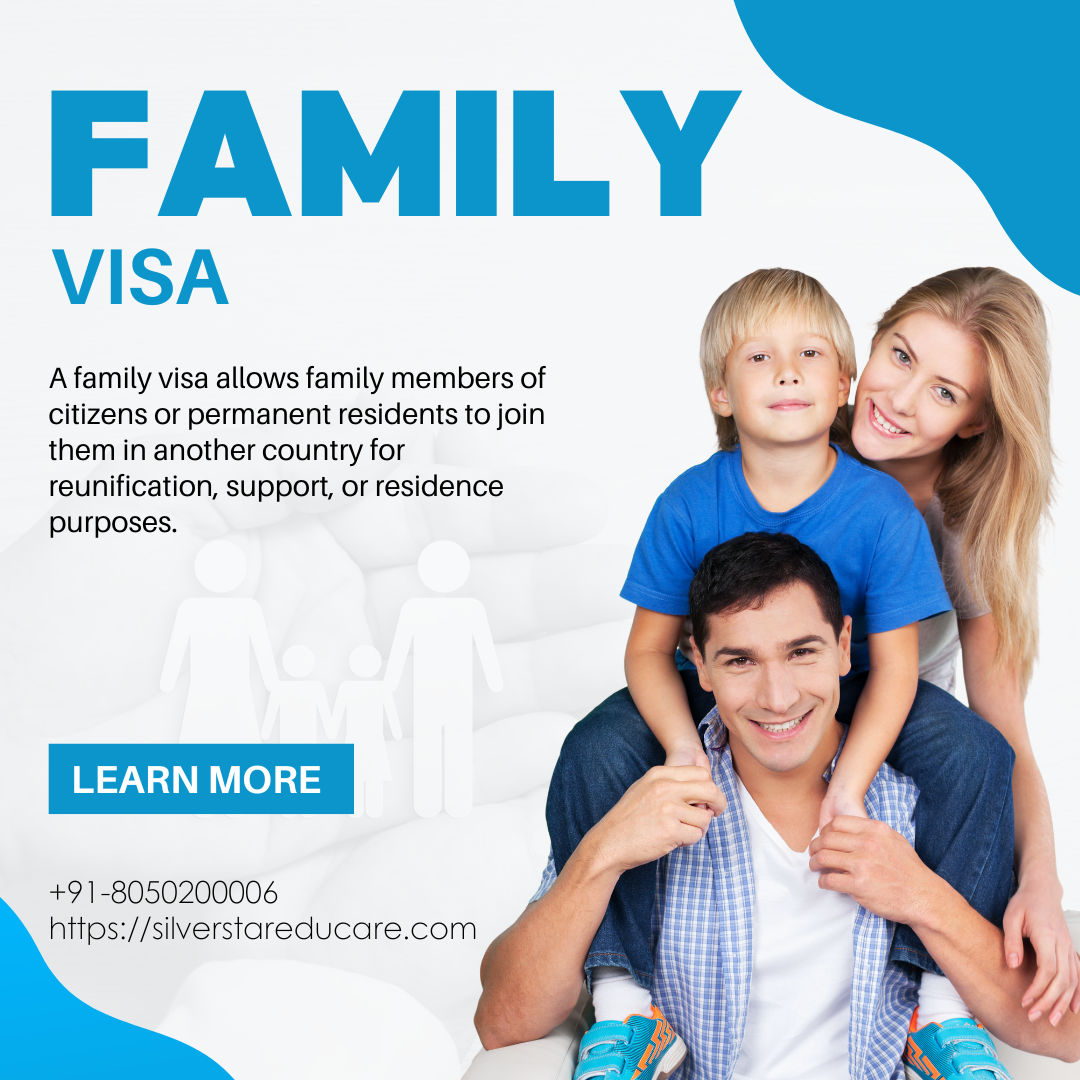- SCO 24-25, Second Floor, Sector 25D, Chandigarh
- contact@silverstareducare.com
- +91-8050200006
- Mon - Sat : 09:00 AM - 18:00 PM
Understanding the Family Visa: A Comprehensive Guide
Related Post
Personality Development: Unlocking Your True Potential
The DHA Exam
22/04/2025
Master the NCLEX Exam with Silver Star Educare
22/04/2025

Any Questions? Call us
+91-80502-00006
Any Questions? Email us
contact@silverstareducare.com

In today’s increasingly globalized world, family members often find themselves living in different countries for various reasons—work, education, or even personal circumstances. As such, reuniting with loved ones has become more important than ever. One way to bring families together across borders is through the family visa. This type of visa allows individuals to sponsor their family members to join them in the country they are living in. In this blog, we’ll dive into what a family visa is, the types of family visas available, the application process, and the benefits of holding a family visa.
What is a Family Visa?
A family visa is a legal document issued by a country that permits family members of a citizen or permanent resident to live with them. Countries around the world recognize the importance of family unity, so many offer visa programs that allow spouses, children, and sometimes other relatives to join their family members who are already residing in the country.
In essence, a family visa helps keep families together when one or more members are living in a foreign country for work, study, or other reasons. It is often one of the easiest and most direct routes to obtaining legal residence in another country.
Types of Family Visas
Family visas are not a one-size-fits-all solution. Depending on the country, there are various types of family visas that cater to different family relationships. Below are some of the most common family visa categories:
1. Spouse Visa
A spouse visa allows the spouse of a citizen or permanent resident to join them in the country where they are living. To qualify for a spouse visa, couples must usually prove that they are legally married and provide evidence of their relationship, such as joint financial documents, photos, and communication records.
This visa is often one of the most sought-after types of family visa, as it allows married couples to live together in the same country, especially when one spouse is a citizen or permanent resident while the other is not.
2. Dependent Visa
A dependent visa typically applies to children or other family members who are financially dependent on the primary visa holder. In many cases, children under the age of 18 (or in some countries, under 21) are eligible to be sponsored on a dependent visa. Parents or guardians may also be eligible to apply if they are financially reliant on their child who is living abroad.
The dependent visa usually comes with restrictions on work and the length of stay, but it is a vital pathway for families to be together, especially when one member is pursuing higher education or a career overseas.
3. Parent Visa
A parent visa is designed for parents of citizens or permanent residents who wish to join their children in another country. This type of visa is often available on a temporary or permanent basis, depending on the country’s immigration laws. Some countries may require the sponsor (the child) to meet a specific income threshold or demonstrate that they can financially support their parents.
Parent visas can be particularly useful for aging parents who wish to live with their children in a different country for better healthcare or familial support.
4. Fiancé Visa
A fiancé visa is for individuals who are engaged to a citizen or permanent resident of a particular country and plan to marry them after arriving in the country. In many countries, this visa allows the fiancé(e) to enter the country for a limited period before getting married and applying for a spouse visa.
A fiancé visa is a great option for couples who have a genuine intention of marrying but are not yet legally married at the time of application.
5. Adoption Visa
An adoption visa is granted to children being adopted by citizens or permanent residents of a country. This visa allows the child to join their adoptive parents and live in the new country. Adoption visas often require proof of the legal adoption process, along with other documentation to confirm that the child’s welfare will be ensured after the move.
How to Apply for a Family Visa
The process for applying for a family visa can vary significantly depending on the country. However, there are a few common steps that apply across most applications:
1. Eligibility Check
Before applying, it’s essential to ensure that both the sponsor (the individual already residing in the country) and the applicant (the family member seeking a visa) meet the eligibility requirements. This often includes proving the family relationship, providing financial documents, and ensuring that the sponsor can support their family member financially.
2. Gather Required Documents
The application process typically requires various documents to establish both the family relationship and the sponsor’s ability to financially support the applicant. Common documents include:
Marriage or birth certificates
Proof of income or employment (for the sponsor)
Proof of the sponsor’s legal status (citizenship or permanent residency)
Evidence of the family relationship (photos, joint financial documents, communication history)
3. Submit the Application
Once all the necessary documents are gathered, the application is submitted to the appropriate government agency. In some cases, the application may be submitted online, while in other cases, applicants may need to visit an embassy or consulate.
4. Attend Interviews (If Required)
For certain types of family visas, the applicant may be required to attend an interview to verify their intentions and the authenticity of the relationship with the sponsor. This is particularly common for spouse visas, where authorities may ask questions about the relationship to ensure that it is legitimate.
5. Wait for Approval
After submitting the application, there will be a waiting period during which the government reviews the documents, processes the application, and makes a decision. This can take anywhere from a few weeks to several months, depending on the complexity of the application and the country’s processing times.
6. Receive the Visa and Join Your Family
If the application is successful, the family member will receive the family visa, which will allow them to enter and stay in the country for a specified period. In some cases, the family member may also receive a work permit or other benefits once they arrive.
Benefits of a Family Visa
Family visas are a vital part of immigration policy in many countries, offering numerous benefits to both the sponsor and the family members. Here are some of the key advantages:
1. Family Reunification
The most obvious benefit of a family visa is that it allows families to reunite, allowing loved ones to live together in a foreign country. This is particularly important for families that have been separated due to work or other circumstances.
2. Enhanced Quality of Life
Having a family member by your side can significantly improve your quality of life in a foreign country. It provides emotional support, a sense of belonging, and stability, which can be especially important when living in a new and unfamiliar environment.
3. Educational and Healthcare Benefits
In many cases, family visa holders are entitled to access public services such as healthcare and education in the host country. For children, this can be a great opportunity to receive a quality education and experience new cultural environments.
4. Pathway to Permanent Residency
In some cases, family visa holders may eventually be able to apply for permanent residency or citizenship after meeting certain conditions, such as living in the country for a specific number of years or demonstrating financial stability.
Conclusion
A family visa is an essential tool for reuniting family members and enabling them to live together in a foreign country. Whether it’s for spouses, children, parents, or even fiancé(e)s, family visas ensure that individuals can remain close to their loved ones, regardless of where they reside. By understanding the different types of family visas and the application process, individuals can navigate the often complex world of immigration with ease, making it easier to bring their families together and build a better life in a new country.
